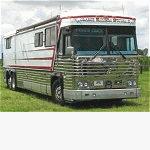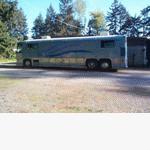| Author | Message | ||
| FAST FRED (Fast_fred)
Registered Member Username: Fast_fred Post Number: 231 Registered: 10-2006 Posted From: 66.90.229.207 Rating: N/A |
Am still attempting to decide weather that CAT 1160-95B is a keeper. To do a compression test would be grand , but in the case of this CAT , the rocker arms need to be removed to pull an injector. The concept of pulling the rockers removing an injector , replacing the rockers and adjusting the valves , taking one cylinders reading , and repeating the dance 7 more times would require more Sainthood than I can muster. SO I wonder what the opinion of using a different system is? Plan "B" I would yank the rockers and injectors once , and use a cylinder blow down tester to find if there is a reason to discard this engine. These are used frequently on gas aircraft and auto engines , any problem with their use to find a major flaw on a diesel? FF | ||
| Jack Conrad (Jackconrad)
Registered Member Username: Jackconrad Post Number: 731 Registered: 12-2000 Posted From: 71.52.182.188  Rating: N/A |
Fred, Should work. A friend just purchased a "blow down" compression tester for his 1.6 L VW diesel engine. I don't think he has used it yet. Jack | ||
| Tim Hoskinson (Tdh37514151)
Registered Member Username: Tdh37514151 Post Number: 240 Registered: 9-2004 Posted From: 65.25.139.50  Rating: N/A |
Hi Fred in my personal opinion putting compressed air into the cylinder while on the combustion stroke is the best way to check for problems. This method will not only let you know if you have a concering compression leak but also by listening to the intake,exhaust ports and oil fill opening what is leaking. Tim | ||
| Skip N (Skip)
Registered Member Username: Skip Post Number: 16 Registered: 11-2006 Posted From: 161.7.2.160  Rating: N/A |
Hi Fred, A "blow down tester" will find a lot. The one thing I always do also is to pull all of the injectors put the compression tester and crank the engine. It should be around 300# I don't have a book so not sure on yours. The biggest thing to watch for is how much diiference there is between cylinders.......but then you already knew that  Skip | ||
| Dan West (Utahclaimjumper)
Registered Member Username: Utahclaimjumper Post Number: 85 Registered: 1-2005 Posted From: 208.66.38.115 Rating: N/A |
Fred, as an A&P with IA active in the trade,I use this system 3-4 times a week. FAA requires a cylinder to not loose more than 25% of the pressure inducted (60/80 or 80/100.>>>Dan | ||
| Jim Wilke (Jim Bob) (Pd41044039)
Registered Member Username: Pd41044039 Post Number: 261 Registered: 2-2001 Posted From: 208.6.60.4 Rating: N/A |
Fred, if you want to check the compression, you will have to have the rocker arms in place for the cylinder you are testing. BUT.... You could remove the rocker arms, remove all injectors, install the compression tester in #1, put the rocker arms back on but you don't have to torque or adjust to check comp. Repeat for all cylinders, then reinstall, torque & adjust. (You'd want to adjust as part of a tune up anyway.) All injectors should be out to test the compression anyway. | ||
| FAST FRED (Fast_fred)
Registered Member Username: Fast_fred Post Number: 232 Registered: 10-2006 Posted From: 66.90.226.205 Rating: N/A |
"All injectors should be out to test the compression anyway." On DD we usually test with the engine running , one cylinder at a time. Not sure the starter could spin the crank as fast as the engine at idle. BUT all I'm looking for is weather its got BIG problems , so the starter spin should tell enough. Will use the heat gun and perhaps only have to do one or two tests , if it fails , it gets to be a boat anchor , or used in the local Cane Fields (for a decade). FF | ||
| Mike Eades (Mike4905)
Registered Member Username: Mike4905 Post Number: 166 Registered: 12-2000 Posted From: 68.200.183.92 Rating: N/A |
Fred Call Bill at U S Coach and ask him or Luke how they would do it. Mike | ||
| Dan West (Utahclaimjumper)
Registered Member Username: Utahclaimjumper Post Number: 86 Registered: 1-2005 Posted From: 208.66.38.115 Rating: N/A |
Jim, thats the whole point, the rockers are not needed for the blow down type test.>>>Dan | ||
| Skip N (Skip)
Registered Member Username: Skip Post Number: 17 Registered: 11-2006 Posted From: 161.7.2.160  Rating: N/A |
Actually if you do a slight modification on your compression tester you don't need the rocker arms on. Put a tee inline between the gauge and the valve, on the remaining opening put a tire vale on so that it can still suck air on the down stroke of the piston. After a few revs it will equalize and give a decent reading. Not perfect but usable FWIW Skip | ||
| Jim Wilke (Jim Bob) (Pd41044039)
Registered Member Username: Pd41044039 Post Number: 263 Registered: 2-2001 Posted From: 208.6.60.4 Rating: N/A |
Dan, I do understand the blow down test (we always called it a "leak down" test. If I were doing it, I would check with compression tester if I had one. This will indicate total highest compression in pounds, how many strokes it takes to get there, and accurately show lowest to highest. If that showed a problem, I would do the blowdown test to indicate whether it was rings, valves, or both. I do not think that somebody that does not do this everyday can tell by listening to the oil filler whether the hiss is to much or o.k. with the same degree of accuracy as the compression tester. I also think that if this bus has not been run much lately it needs to go for a 200 mile trip before analyzing the compression. Fred, I also think that if "Da Book" gives the compression pressures at cranking speed, doing the test while running is likely to give a higher reading, letting marginal engines pass. | ||
| larry currier (Larryc)
Registered Member Username: Larryc Post Number: 162 Registered: 2-2007 Posted From: 207.200.116.13 Rating: |
It would not be very hard to make a test stand. Start it up and see what you think. I don't think you will get alot of info with the leak down especially with a cold engine. I have observed liners leak into a cylinder and antifreeze will flow through the rings at a surprising rate. Its been a while but I think liners are round and pistons are egg shaped when cold, pistons are round at operation temperature. Remove the oil filter and cut it open. You can see enough from that alone to make a pretty good decision. If I had inherited this engine and needed it, I would pull the pan and look at a main and rod bearings and if ok, put it to work. If its a Cat without a dropped valve or a hole in the side of the block, taking it apart seems like wasted effort, lets see if the fuel pump etc. are good and if it will run without swapping fluids. (Message edited by larryc on February 27, 2008) | ||
| john w. roan (Chessie4905)
Registered Member Username: Chessie4905 Post Number: 893 Registered: 10-2003 Posted From: 71.58.48.5  Rating: N/A |
Fred, if you are deciding whether or not to buy the coach is one thing. If you just trying to decide whether or not to keep the engine, why not run it a while. Get it good and warm and get one of those temperature laser probes and check the temperature at each exhaust port on the exhaust manifolds and see what the difference is. How does the exhaust look after hot. Does it idle clean on both banks or just one or not at all? Make sure you have fresh fuel with at least 20 miles of running. If that looks good, and the idle sounds good without any noticeable miss, take an oil sample and have it checked. Of course this is after an oil change and about 50 to 100 miles of driving.I wouldn't personally waste the time on a compression test. If it has a noticeable miss and blue smoke at idle, that infrared probe should narrow it down to a particular cylinder. Then you can check just that one or two. If the probe doesn't help narrow it down, then you can decide whether it is worth the test. If the engine has problems and the coach is really nice, just tear it out and disassemble it and repair or discard. No different than if it had a Detroit or any other diesel. This of course sounds simple unless you don't do any mechanic work on a diesel. | ||
| George M. Todd (George_mc6)
Registered Member Username: George_mc6 Post Number: 370 Registered: 8-2006 Posted From: 207.231.75.253 Rating: N/A |
John is right, idle it and listen, if it sounds good, run it. Even easier, crank it and listen. If it cranks over without a noticeable change in speed, the compression is the same on all cylinders. If the cranking speed is irregular, as in a noticeable variation in speed every second turn, or several obvious changes, the compression is greatly different between cylinders! Quick, cheap, and EASY! G | ||
| FAST FRED (Fast_fred)
Registered Member Username: Fast_fred Post Number: 236 Registered: 10-2006 Posted From: 66.90.229.118 Rating: N/A |
Well so far it ran 160 miles , mostly on FL back roads and as usual for a coach (even with a slushpump) the acceleration is not starteling. Majestic perhaps. Seems fine at 75mph + with no overheating or other signs of distress, BUT she sure is noisy compared to a DD , but the oil pressure after 80 FAST miles was still 65 at idle.Sure not a DD! AND she blows light BLACK smoke from the pax side and 2x as much BLACK smoke from the drivers. The smoke is visiable weather at cruise at 45mph , floored , or cruising at 75 . Sounds like injector love will be first thing to try. Happily!!!the "hole in the bus" was very carefully measured and a Ser. 50 and either ZF 6 speed or Allison H 7 series 6 speed will plop in. 75 at 1400rpm does sound good. A loss of my files cost the bookmark to Daris , who has the road speed computer for coaches. Can't do Speed/RPM mental masturbation with out someone else doing the math!! FF | ||
| Buswarrior (Buswarrior)
Registered Member Username: Buswarrior Post Number: 1214 Registered: 12-2000 Posted From: 76.68.122.198  Rating: N/A |
FF, Daris's web coordinates changed: Here's the site, the calculator is down the left as before: http://www.thebouthilliers.com/4106/ And Mallie's speed calculator is another one: http://mallie.home.cwis.net/page12.html happy coaching! buswarrior | ||
| john w. roan (Chessie4905)
Registered Member Username: Chessie4905 Post Number: 894 Registered: 10-2003 Posted From: 71.58.48.5  Rating: N/A |
BTW, diesel just hit 3.99/ gallon here. OWWW! | ||
| FAST FRED (Fast_fred)
Registered Member Username: Fast_fred Post Number: 239 Registered: 10-2006 Posted From: 66.90.229.94 Rating: N/A |
Thanks for the sites, Now if I only could find out the stock axle ratio on a 56 Flex that had a 6-71 from the factory. FF |